
‘In her signature role in “American Graffiti,” Candy Clark was the cotton-candy blonde with the creamy skin and platinum wig. Cast as Debbie Dunham, a party girl who loves to cruise and hot rod, Clark was the bouffant exclamation point who purred, “I really love the feel of tuck-and-roll upholstery.”
‘Clark got paid “something like $300 a week” for her work on “Graffiti” – she can’t remember, it was 35 years ago – but the movie earned her an Oscar nomination, launched a moderately successful career and ultimately gave her a steady income from hot-rod shows and personal appearances.
‘Occasionally, she still acts. In “Zodiac,” the David Fincher thriller that opened early this year, Clark had a tiny walk-on as Carol Fisher. A San Francisco Chronicle employee until her death in 1993, Fisher was the Letters to the Editor staffer who in the late ’60s opened the first of several letters sent by the anonymous Zodiac killer to the newspaper.
‘”I don’t count on acting for a living anymore,” Clark says breezily. “It’s a nice perk. If it happens, great. But it’s not my focus all the time.”
‘Weirdly enough, Clark says, she resisted being an actress. She was modeling in New York in the late ’60s, during the era of Twiggy and Penelope Tree, when she got a job as an extra on a Dustin Hoffman movie, “Who is Harry Kellerman and Why Is He Saying Those Terrible Things About Me?”
‘”I was in a crowd scene with 200 people and I was just fascinated. I thought, ‘I want to do more of this.’ I went back to (casting director) Lynn Stalmaster’s office and there was this casting director, Fred Roos, on his way out. He said, ‘I’m gonna watch them shoot the screen tests for ‘The Godfather.’ You want to come?’ ”
‘It was one of those moments. Accidental, life-changing. Clark got in a cab with Roos and met Coppola at the screen test, and soon she was in Los Angeles auditioning for a part in John Huston’s “Fat City.” She didn’t even know who Huston was.
‘”Fred Roos brought me in for that. I’ll never forget this: I told him, ‘I don’t want to do dialogue or learn lines. I just want to be an extra!’ And he kept buggin’ me and buggin’ me and I finally said ‘OK, if I can go to Disneyland I’ll come out and try out for the film.’
‘”I don’t know what they saw in me. I had no idea how to memorize lines or anything. It was really hard on me.”
At the screen test for “Fat City” she met her co-star Jeff Bridges, and entered a relationship that lasted “three or four years, I can’t really remember. It was nice to get a part and a boyfriend in the same day. Talk about fabulous.”
‘”Graffiti” came next. Clark won the Debbie part at a huge cattle call, and then shot the film for 28 nights, mostly on the streets of Petaluma, which doubled for Lucas’ hometown of Modesto. The Mel’s Drive-In scenes were shot in San Francisco at the original, long-defunct Mel’s on Van Ness Avenue near Mission.
‘No one expected “Graffiti” to be a hit. Lucas’ maiden project, “THX 1138,” has flopped, and few saw the merit in a set-in-1962 nostalgia flick with a wall-to-wall rock ‘n’ roll soundtrack. Lucas shot it for $850,000 – $40,000 of which paid for the songs. The price tag for those same tunes today would be in the millions.
‘None of the costuming was done in advance, she remembers, “so I just had to, like, try on what they had. I picked a blue-and-white striped, spaghetti-strap dress from a secondhand store. I said, ‘This works.’
‘”Luckily I picked a sweater with this chain at the neck ’cause it was freezing that summer and that was my only protection against the elements.” So low-rent was the “Graffiti” production that Clark and her co-stars, Harrison Ford and Ron Howard included, weren’t given chairs to sit on between takes. They sat on the curb instead.
‘And Lucas? Was the future “Star Wars” wunderkind, the man who changed commercial cinema, easy to work with? Hardly. Most of the actors complained that remote Lucas rarely talked to them or made a comment at the end of a take.
‘”He was really quiet,” Clark says diplomatically. “We quickly learned that it was only going to be one take, so we had to get it right the first time. They said, ‘Don’t make mistakes ’cause we’re gonna print it.” — Edward Guthmann
____
Stills
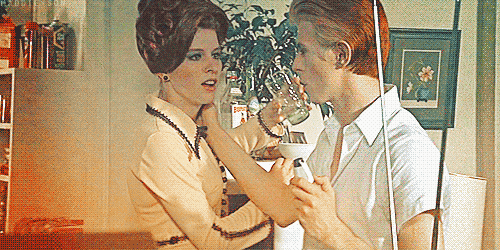

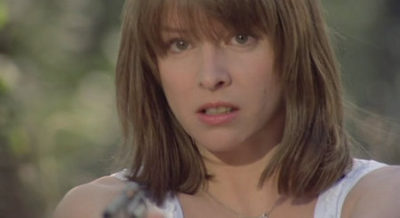

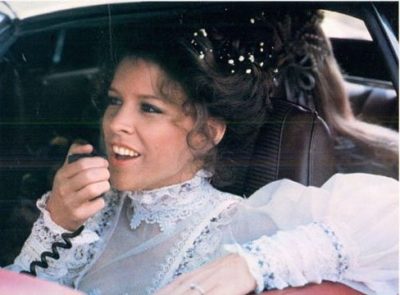


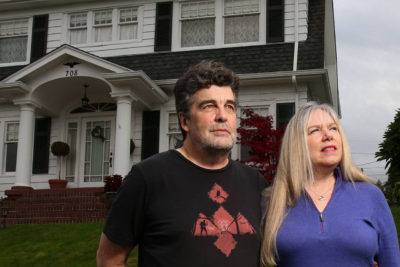
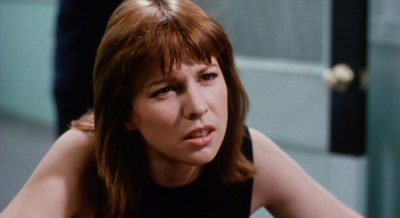
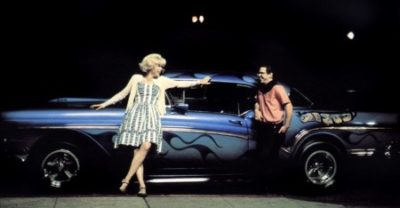
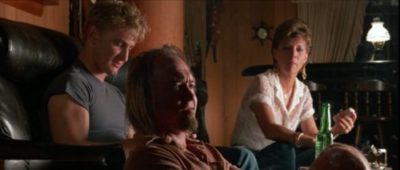
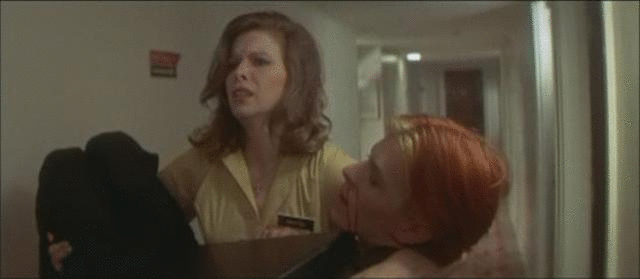
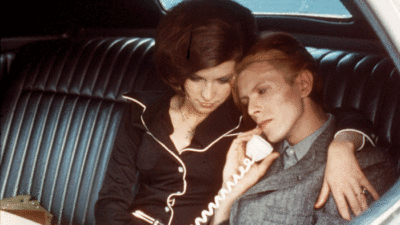
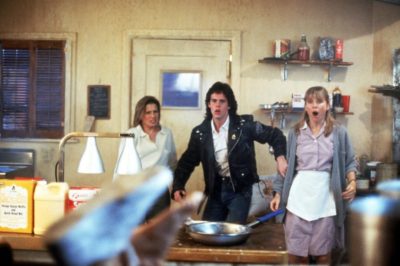

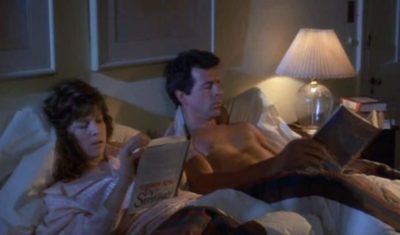



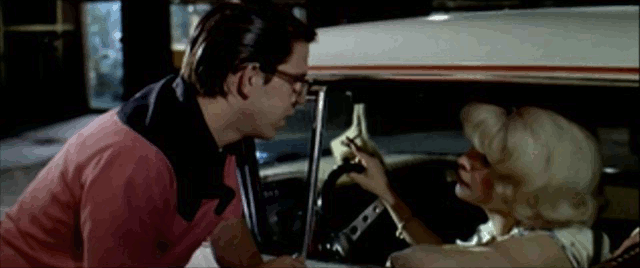
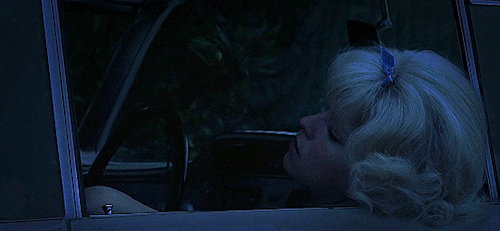


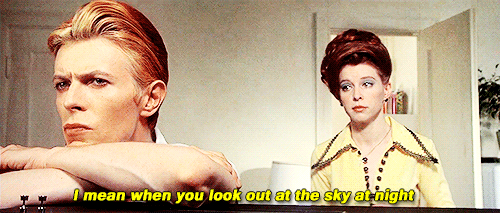
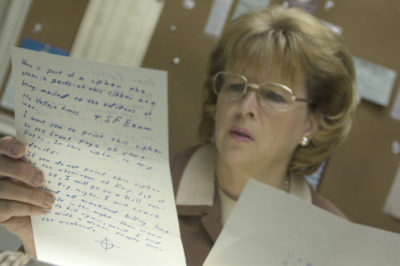
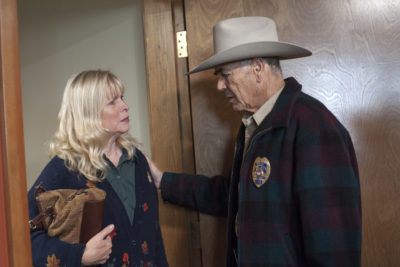


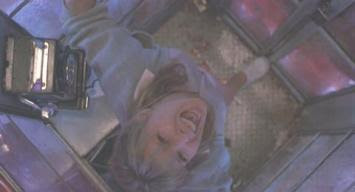

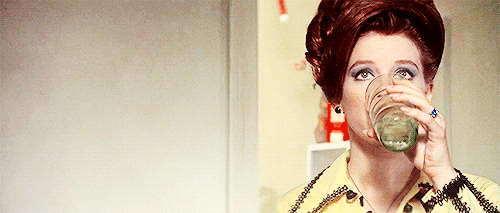
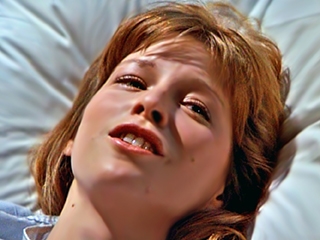
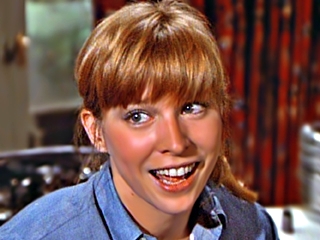




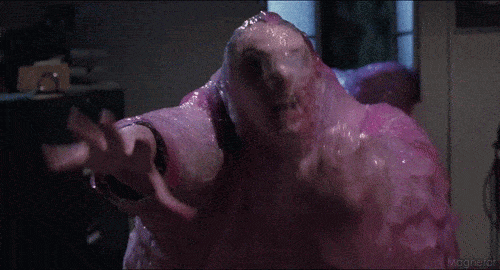
___
Further
Candy Clark Website
Candy Clark @ IMDb
Candy Clark @ Facebook
Candy Clark @ Twitter
Audio: Candy Clark Live On Game Changers With Vicki Abelson
Candy Clark and Rip Torn on THE MAN WHO FELL TO EARTH
‘the man who fell to earth’s’ candy clark talks bowie behind the scenes
CANDY CLARK ON ‘FAT CITY’
Our interview with CANDY CLARK
Candy Clark helps close out Plaza Classic
A Q&A With Candy Clark
Cruise Control With Candy Clark
AN EVENING WITH CANDY CLARK
____
Extras
Candy Clark Is Presented With A Lifetime Achievement Award
THE ACTOR’S JOURNEY® – CANDY CLARK
SHIT I LOVE with JASON STUART – Guest CANDY CLARK 8/17/18
Candy Clark | Circus of the Stars | December 16, 1979
____
Interview
from Money Into Light

Before making FAT CITY, you were a successful fashion model in New York. What encouraged you to become one?
It seemed like something I could easily do. It also paid well!
Did you travel to New York with the idea of becoming a model?
No, I just went there on a one-week vacation. I was supposed to be going with a friend of mine, but she stood me up. I had bought a youth-fare ticket that cost about $45, and I boarded a midnight TWA flight. The airplane was making its landing around dawn, and I was determined I wasn’t going back to Texas when I looked out the window and saw New York City all pink and gold in the morning light. I fell in love with NYC from the air.
How long did you model for?
From ’68 to ’71. It took me about a year to get comfortable in front of a camera. I had the misconception that you had to freeze for the camera, so it was an uptight experience for me. I eventually realised that the camera freezes you. Then it became fun. I was started to get some repeat clients. Mostly I did teenage modelling for magazines like Seventeen, Ingenue, Glamour and Co-Ed. It didn’t pay as well as catalogue modelling but it was better for your status as a model if you had tear sheets from magazines in your portfolio.
Did you ever come across Patti D’Arbanville in New York?
Yes, we both used to go to a nightclub called The Salvation down on 1 Sheridan Square. We had a mutual friend in Leslie Schiff. I went to his apartment one evening, and there was Patti, all dressed in black leather. She kind of glared at me, and wouldn’t speak. I later found out she was only fourteen years old. After that evening though, we’ve been friends ever since.
You were an extra before FAT CITY. What was the film you did?
I went to a casting office and got a part as an extra in the Dustin Hoffman film WHO IS HARRY KELLERMAN AND WHY IS HE SAYING THOSE TERRIBLE THINGS ABOUT ME? (1971). I was in a crowd of about two hundred people. It was about $35 a day and was lots of fun, so I wanted to do more, so I went to Lynn Stalmaster’s office to drop off my picture and try and get more work. Fred Roos was there, who was casting THE GODFATHER (1972) at the time. As he was leaving, Fred asked me if I wanted to go with him to see the screen tests being done for THE GODFATHER in Queens. I met Jimmy Caan and other actors, and even did a little screen test of my own with Francis Coppola. I went back every day to watch the actors trying out. They couldn’t get rid of me!
How did you get involved with FAT CITY?
Fred Roos called me from L.A. and said ”I want you to ty out for this part in FAT CITY.” I really just wanted to be an extra. Plus, all my hard work in modelling was starting to pay off. Weeks went by, and Fred kept insisting, so I told him ”OK, but I want to go to Disneyland and I want to go to the Academy Awards.” I thought I was driving a hard bargain but to my surprise he said ”Yes, I can arrange that.”
How was the experience of attending the Academy Awards?
It was really exciting, and the highlight of my trip to Hollywood. I sat on the third balcony behind this huge pillar with rented binoculars that I got in the lobby.
What was the experience of auditioning like?
It was hard because I really didn’t know how to memorise anything or how to do a scene. On the big day of the audition, I wore a silk blouse, which was a mistake since it was a hot summer’s day and it made me sweat. I was really scared when they called me in. Fred was there with John Huston, the producer Ray Stark and a guy called David Dworski. It was an emotional scene and when the crying part in the scene came up, I figured I would duck my head and pretend to cry, with my hat from Disneyland covering my face. I said ”Thank you” and pretty much ran to the elevator, just mortified. I heard Fred come up behind me and say ”They want you to come back to do a screen test.” I remember standing there, pushing the elevator button repeating ”I just want to be an extra!”
How did you prepare for your screen test?
I called my mother in Fort Worth and asked her to come to L.A. to help me learn the lines. Jennifer Salt and Margot Kidder were also testing. I remember arriving and there was this cutaway car with just seats and a steering wheel. I did my test with Jeff Bridges, who was very handsome, very down to earth, and didn’t seem like he was an actor. I didn’t know he had already been cast. I thought I was terrible in the test, but lo and behold, I got the part.
Did you have any problems adjusting to acting?
Yes, I sure did. Pretty quickly they realised I couldn’t act at all. They got a coach, Jeff Corey, up from L.A. to Stockton where we were filming, to try to teach me acting overnight, but it was impossible. My role progressively got smaller and smaller.
What are your favourite memories of working with John Huston?
He was one of these Hemingway types: manly, British accent, tall, elegantly dressed. I would hang out on the set watching the actors work, and on one nightshoot he wore a Sherlock Holmes cap, a matching cape, and a beautiful Irish wool suit. He was always smoking and inhaling Dunhill cigars. He was also a bit of a bad boy and tried to get Jeff and me to drink tequila with the worm in the bottle. We were too chicken.
How was he as a director?
He was very patient and forgiving. He tried to help me but I was pretty hopeless. I didn’t understand movie set language or what he was trying to get me to do. It was a whole other world. He’d simply say ”Let’s do it again!” I wish I’d made the film farther on in my career. I could have done the part really well, and been proud of my acting.
What was the experience of fiming in Stockton like?
We were there for two months, and we all had a lot of fun behind the scenes. Everybody socialised together and it was a close, tight-knit group. We all stayed at the Holiday Inn, next to the Civic Center, where there was always something going on – roller derbies, boxing matches, dances. We used to eat all the time in a restaurant called The Azteca, on the wrong side of the tracks. The food was great, and it was fun hanging out with John Huston, Ray Stark and the actors. One day we went there and there was blood on the sidewalk, so we never went back. Stockton was a little surreal. They had these parks where classical music was piped in through megaphones, and lonely old, sometimes drunken men would just sit around waiting for the crops to come in.
What are your strongest memories of Susan Tyrell?
She was just like her character, Oma. She lived on a houseboat, and Jeff and I would visit her sometimes. There were always these strange and unique characters there – people she’d met on the street or in one of the parks. I remember there was a guy who played the pie plates, spoons and washboard. It was all very entertaining and artistic.
How about Ray Stark?
Ray was crazy about John Huston, and got up early every morning to cook his breakfast for him. After we returned to L.A., he invited Jeff and I to his house in Beverly Hills. Ray had all these beautiful, oversized bronze sculptures in his backyard, and he inspired me to collect art.
What was your reaction when you saw the final film?
I thought it was fantastic. Leonard Gardner’s writing is like Steinbeck to me; just great, great writing. The film really captured these people who never really succeed and live on the fringes of society. Susan Tyrell was superb and completely deserved her Oscar nomination. Stacy Keach and Jeff were superb too.
How do you feel about your performance now?
I just cringe with embarassment when I see myself in the film. I didn’t understand what the scenes were about or the urgency needed in certain scenes. I was just reciting dialogue. People watch the film now and they don’t know what I was going through. I basically tried to model my way through the picture, as it was all I knew. After the film I became determined to improve as an actress, and came back to L.A. and started taking acting classes. I slowly but surely started to figure out what acting was supposed to be about.
____________
14 of Candy Clark’s 69 roles
__________
John Huston Fat City (1972)
‘John Huston’s sombre but compassionate boxing drama is a criminally underseen late-career masterpiece from the great director. Peppered with outstanding performances this gritty yet affectionate look at the world of small-time boxing highlights a down-and-out fighter and a young up-and-comer, both moving through a world of seedy gyms and flop houses.’ — Powerhouse Films
Trailer
_____________
George Lucas American Graffiti (1973)
‘When I first saw the film’s ending it made me very mad because here we’d been laughing and very charmed by the characters and the last couple of minutes of the film we see that this character got killed,” she said. “I hated that tacked-on ending. It had been really fun and light and it seemed like an unnecessary tag-on, a down note on a very up film.’ — CC
Excerpt
Candy Clark reveals How I Got The Part in American Graffiti
______________
Nicolas Roeg The Man Who Fell to Earth (1976)
‘I was the first person hired, really, before it even got financing. I was with [then boyfriend] Nic Roeg and he was having a meeting and I was sitting out in the lobby waiting for him and he said, “Well here, read this script and tell me what you think.” He was in the meeting for a long time so I read the whole thing and when he came out I said, “Wow this is a great film, you have to do this” and he said, “you’ve got the part!”. It was that easy. I had the part for about six months, maybe seven, while they were getting it together, so I really had time to think about my character and what I wanted to do with it.’ — CC
Trailer
______________
Jonathan Demme Citizens Band (1977)
‘Seeing on the horizon the “Electronic Age” described towards the end of The Guttenberg Galaxy, Jonathan Demme spreads his arms wide and welcoming. A cacophony of scrambled transmissions over the opening credits establishes rural Nebraska in the grip of CB-radio mania, imagery and soundtrack continually and pointedly wavering between static and harmony. For the characters, it’s not just a novel technique but a new dimension to be explored: People turn on their “idiot channels” and their psyches take flight, suddenly they’re ribald storytellers with monikers like “Electra” or “Warlock” or “Chrome Angel” or “Hot Coffee.” At the center is the repairman (Paul Le Mat) who takes upon himself to enforce the rules and regulate the crackpots clogging up the airwaves. (“Small minds and big antennas,” he sighs at the local bigot broadcasting his venom.) While he plays with his vigilante persona, his girlfriend (Candy Clark) doubles as a raunchy on-air seductress and his brother (Bruce McGill) turns himself into a threatening disembodied voice in order to articulate their familial tensions. Inverting their romantic triangle, the film’s parallel narrative finds two women (Ann Wedgeworth and Marcia Rodd) realizing they’ve been married to the same trucker (Charles Napier), “a communications problem.” Fantasy can breed isolation yet heaven here is other people, everybody is brought together by the crusty father (Roberts Blossom) who sits sullenly at Le Mat’s table but bubbles with joy when jabbering roadside lingo into the CB speaker. “It’s a funny country. Everything’s going mobile. If you can swing that…” A vivacious poem of American restlessness, a sprawl of campers and motels and junkyards lovingly captured by Demme’s freeze-frames and dissolves, a vision of technology made vibrantly human. In the rear-view mirror are The Sugarland Express and Nashville, up ahead are Peckinpah’s Convoy and, of course, the Internet.’ — Fernando F. Croce

_______________
Michael Winner The Big Sleep (1978)
‘But now we come to the case of “The Big Sleep” (1978), with Robert Mitchum stepping into Bogie’s shoes. The movie isn’t a classic, but it does make sense. Does it ever. We get Mitchum’s voice explaining things on the sound track, and we get flashbacks to remind us of key scenes, and when characters confess to a crime we get scenes picturing them. And yet, when the movie’s over, we’re still mystified. Chandler’s plot is so complicated that maybe Hawks was right in 1946 when he ignored the loopholes. What really matters in a movie like this isn’t plot, anyway, it’s style: How the characters talk to each other, and wear their clothes, and smoke cigarettes and hold guns. The style in the new “Big Sleep” is confined mostly to three actors: Mitchum, Candy Clark and Richard Boone. The movie is a disappointment otherwise.’ — Roger Ebert
Excerpt
_______________
Larry Cohen Q (1982)
‘Q: The Winged Serpent was written and directed by Larry Cohen, a filmmaker who knows a thing or two about making giddy horror flicks. (He also did It’s Alive and The Stuff.) Cohen utilizes old-fashioned stop-motion animation to create his creature. The thing looks like something out of a Ray Harryhausen production. The beast kills people in fairly graphic fashion, plucking them out of the sky or biting off a body part. Because the deaths are substantially gruesome, we don’t mind so much that the creature effects are utterly unconvincing. Then again, done today, Q would utilize state-of-the-art CGI, but probably wouldn’t be anywhere near as entertaining as the low-fi approach utilized here.’ — Aisle Seat
the entirety
_______________
Lewis Teague Cat’s Eye (1985)
‘All three of the stories in “Cat’s Eye” depend on special effects: The electric room, the high-rise terror, the little gremlin (made by Carlo Rambaldi, who also constructed E.T. and King Kong). The special effects are effective and understated, allowing the foreground to be occupied by some of our basic human fears, of pain for loved ones, of falling from a great height, of suffocation. Stephen King seems to be working his way through the reference books of human phobias, and “Cat’s Eye” is one of his most effective films.’ — Roger Ebert
Excerpt
_______________
James Foley At Close Range (1986)
‘A downbeat tale [by Elliott Lewitt and Nicholas Kazan] of brutal family relations, James Foley’s At Close Range is a very tough picture. Violent without being vicarious, this true story is set in a small Pennsylvania town in 1978. Story introduces young Brad (Sean Penn) as just another rather tough kid with an eye for a new girl (the charming Mary Stuart Masterson) and fiercely protective of his brother (Christopher Penn).’ — Variety
Trailer
______________
Chuck Russell The Blob (1988)
‘In the scene where I’m in the phone booth, the blob was made out of parachute silk, and it was painted pink and had some kind of gel in it. I remember the prop guys trying to get that thing up on top of the booth so it could creep down the sides of the glass, and it was really heavy, and they had a hard time lifting it. So I was looking at this piece of parachute silk, and I was supposed to be terrified because I’m about to get killed, and it was creeping down the glass of the phone booth, and I was thinking, ‘This is not scary! Well, I’ll just keep doing my part, and hope that it’s gonna work!’ — CC
Trailer
_______________
Fran Rubel Kuzui Buffy the Vampire Slayer (1992)
‘It’s kind of a miracle that a Buffy The Vampire Slayer TV series ever happened. To understand why, you have to witness the show’s very humble origins, to watch the movie that started it all—the one Whedon probably wishes you wouldn’t, the one that Buffy fans generally ignore, the one that only really gets discussed today as a footnote on what it ended up improbably inspiring. It’s rare enough that a show based on a movie turns out good or even popular. But for one to grow from the soil of a forgotten, very mild box-office success with mixed-to-negative reviews, only to take on a life of its own and build a loyal fan-base and run for seven whole seasons? We’re entering miracle territory.’ — The AV Club
Trailer
______________
David Fincher Zodiac (2007)
‘Throughout the film’s 2½ hours, Fincher maintains the sort of locked-in, ultra-focused hold on his material he’s displayed before, but with a touch that, if not exactly gentle, is less ferocious and overbearing. Due in part to the times at which certain scenes were shot, as well as to the limpid quality of the HD images (“Zodiac” is the latest big production shot with the Thomson Viper Filmstream Camera), a certain twilight, afternoon-into-darkest-night atmosphere dominates, appropriately enough given the characters’ slow descent into the murky abyss. There’s no showing off with technique this time, no pandering to the public’s baser instincts, just extremely disciplined filmmaking in which the camera is always in exactly the right place. Notably imaginative are the transitions and means of conveying the passage of time, marked at one point by the stop-frame construction of the landmark Transamerica Building.’ — Variety
Trailer
_______________
Steven Soderbergh The Informant! (2009)
‘Soderbergh builds the film around Matt Damon’s character and performance, with a breezy Bond knock-off score from Marvin Hamlisch (of The Spy Who Loved Me fame) and a colourful, wry style. In fact, the film is almost too wound up in its lead’s world, short-changing those around him — especially the excellent Melanie Lynskey as Whitacre’s supportive wife, whose degree of complicity in his extravagant lies remains vague, though she gets one marvellous late-film moment as a single tear marks the point when she has to cry “enough”. Though Whitacre sees everyone as a stooge, Soderbergh has a knack for filling bit parts with welcome players who carry slightly naff but enduring bits of film history, making room for Clancy Brown, Candy Clark, Tom Wilson and Frank Welker.’ — Empire
Trailer
______________
Griff Furst Cold Moon (2016)
‘An eccentric mix of veteran actors, Southern Gothicism and neo-noir lends “Cold Moon” a certain charm as a ghostly revenge thriller. This handsome-looking potboiler is well-crafted on various planes, even if telepic and direct-to-video helmer Griff Furst’s mostly game-upping latest feature is also occasionally at tonal odds with the screenplay’s campier “Creepshow”-type horror aspects. Nonetheless, as guilty pleasures go, this one rates a solid B. The performers are impressively committed, though they run a gamut: The principals are fine while some older, name actors occasionally go over-the-top.’ — Variety
Trailer
______________
David Lynch Twin Peaks: The Return (2017)
‘The nasty Richard Horne will get Steven and Gersten and the armpit rash girl and her friend involved in his drugs deal with the sinister Red. Chad is already involved, as is the last of the Renaults. We will see signs of this developing. In the last episode they will all get caught in a big net dropped from a tree by Hawk. But that’s later. This week, Richard will visit his mom, Audrey, who will be clad in some kind of fetishy disability costume like Rosanna Arquette in CRASH (the good one). Candy Clark may well do some more epic complaining. But maybe this time she’ll soften, also. Third time’s the charm.’ — Shadowplay
Trailer
*
p.s. Hey. ** David Ehrenstein, Ha ha, you’re so hard on the straight marketing approach, and yet it’s been a winning strategy in prostitution possibly for centuries before you and I were born. Everyone, Today on FaBlog Mr. E conflates Ken Russell and Brett Kavanaugh, check it out. ** Bill, I do not take your approval lightly, thank you. Mm, its been a while, but they were fairly mesmerising, rougher and more dynamic than the recordings I listened to of theirs recently, but the recording decisions seem right. Worth seeing, for sure. Barry Hannah had a very unique voice, yeah, and when he was most in it and not pushing too hard on the narrative, it’s a pretty distinct, tasty thing. I read about your heatwave. Scary. Did you hit the festival anyway? ** Damien Ark, Hi, Damien. Good to see you, man! Yeah, the slaves are generally more openly into the chubs, not sure what the means. Thanks about the posts, and I’m happy you’re at least lurking, and more than happy when you pop in. Take care. ** JM, Hi, man. Oh, I understand, you’re as busy as I am. And you have that big show/adaptation coming up. So wish I could see that. I haven’t read enough King to be a fan or not. His prose just kind of wasn’t very interesting to me. But I should try again. It’s been forever. And I will happily skip ‘It 2’, thank you. Yeah, I’ve started reading the new SCAB, and it’s great, of course. Love your piece. The ARTE project is just kind of cursed, but I think it’ll work out well ultimately. It keeps proceeding, which I guess means something. But, boy, do I passionately await the day when the script is finished, at least until we get close to the shooting, which probably won’t be until late next year at this point, because then it’ll be other people’s curse to deal with for a hopefully long while. Take care and love to you, buddy. ** IsKeatonComing?, Is he? I go to haunted houses by myself, but, yeah, you have to be an aficionado of the form to enjoy them alone. Yeah, only two Kings. I seem to prefer waiting for the movie adaptations. I’ve seen a billion of those. Yeah, I think wacky wasn’t up my alley back when I read those books, but I think wacky is a bit more in my alley now. Shit, I’ll just get one. It’s not like you can’t find his used books for 1 euro here. Horror movies are the new art films, or wannabe art films these days. I get why people want to make arty horror films in the same way I got why people wanted to make arty porn films back in the 70s, but that pudding often doesn’t have enough proof in it ultimately or something. ** Steve Erickson, Rule of thumb: never trust that what an escort writes is entirely out of emotional honesty. Even at their most cathartic, there’s usual a calculated angle of some sort. I put together a Makino post this weekend. There are three or four of his films online, and several excerpts, and some documentation of his live performances. More than I thought I would find. Enjoy the festival screenings. Curious to hear your early reports/takes. ** Dominik, Yes! My share of the new SCAB’s birth on FB has gotten a giant number of ‘likes’, whoo hoo! I’ve read about half of the issue so far, and, yeah, i;’s fantastic, and, yeah, quite possibly the best one so far. Congratulations, to you and to us! Oh, that would be so nice to coordinate an Amsterdam trip with you. I’ll let you know if something comes up. Still hoping you’ll get to Paris someday. And also still hoping I can visit your hometown. I think I did about half of what I thought I’d do last week. We had a huge metro strike here on Friday that killed a couple of fun things off. My reader thinks they will be ready to read my novel late this week, and I am jumping out of skin and trying not to. Have the best ever early week, pal! Love, me. ** _Black_Acrylic, Yes, I did think of you when I found that Leeds fella. Doesn’t look familiar? Your friend’s sculpture looks great. Very nice indeed. ** Kirk, Hi, Kirk. Welcome, nice to meet you. Well, thin is mostly in among escorts I pick for the posts. If you go the escort sites themselves, it’s muscles and pecs for days. One problem is — and I can’t explain why this is — that the muscle guys tend not to write very interesting profile texts, and the posts are largely about interesting profile texts. The muscle guys tend to just write the equivalent of ‘You see my pix, you know I’m hot, you know you want it, hire me’. ** Brendan, Hi. Yes, and I am still not free of mine god damn it, through fault of my own, I will add, but I think I’ll be in the clear this afternoon, Satan willing. Sad about Ric Ocasek for lots of reasons, no small one that he produced a great Guided by Voices album. Take care, man, and more very soon. ** Okay. Recently a friend of mine asked if I had done a Candy Clark Day. I said I hadn’t. He asked if I would please make one. I said yes, and I have, and I’m not sorry that I have one little bit. See you tomorrow.




 Now available in North America
Now available in North America 
Wondeful to see this Candy Clark Day. She’s such a fascinating individual. Not “an actress” in the conventional sense, but her performance in “The Man Who Fell To Earth” is utterly indelible. She’s a tad like Tuesday Weld having one foot in “the business” and the other out of it. She’s managed to appear in a number of other great movies — “Fat City,” “Q,” “Zodiac” — but TMWFTE is “The Moon and The Stars” IMO.
I really don’t like the walk-through haunted house thing. I’m spoiled by the dark-ride. Don’t read it on the metro, I’m afraid it would create some kind of dark black hole of evil to see someone reading a King novel on the Paris metro. I’m certain there is one sign/symbol/thing that would kill each person of fright. Funny the things you’re afraid of. I remember at this furniture store there was a pig lady in a chair that was absolutely horrifying. And the movie Mausoleum for some reason. And the Old Man mask from the 70’s, which I understand these days. Or the first time you see a skull. Weird, the first guy I ever saw a skull with died so young. Hell, I just miss Freddy Kruger sometimes. Old film, they need to use old film. And all the acts are like closets stuffed with clothes. I could imagine PGL as a zombie flick, maybe it’s just the lighting. “The Dead Ate Him In His Grave!” Punkin fever. If you carve a Jack o Lantern once a year it saves you from carving up some pretty boy. Hollywood just needs more puddin in the pie. Vorhees underwear edge style. If you take the sex out of horror, then you’re left with, well, wood. Off to start a Halloween story
The Francis Bacon: Books and Painting show that’s just opened at the Pompidou looks to be well worth seeing. His personal archive held more than 1300 books, it says here, from Bataille and Conrad to Nietzsche and Leiris. I saw a great FB retrospective at Tate Britain a few years ago, but this one seems to come at his later work from a different angle. I’m a fan and am intrigued by the synopsis anyway.
Hey dennis
did not expect Q and The Man Who Fell to Earth to pop up on this post. I enjoyed that. Great escort post yesterday, couple of them had some juicy short story potential
Cal
My NYFF did not get off to a good start with YOUNG AHMED. It’s OK stylistically, but the small misgivings I had about THE UNKNOWN GIRL grew dramatically with this. The Dardennes seem ill at ease with their socially conscious neo-neo-realist style but not yet ready to move away from it. Here, they’ve written the worst script of their career, simultaneously too oblique and on the nose.
Tomorrow, I’m seeing ZOMBI CHILD in the morning, coming home for a phone interview with WHERE’S MY ROY COHN? director Matt Tyrnauer and then going out again to see the eye doctor. I hope I can get an easy answer and solution to my blurry vision.
Dennis, Good day you got here. As usual. I bow to you, sir.
Hmm, I just feel like the self-publishing thing hasn’t caught on like the Bandcamps and Soundclouds and those. Maybe because you still a lot of times have to plunk down something for it?
I see self-publishing getting a lot of side eye from people too, writers and readers. I was telling somebody at work, for example, about Sypha’s books. Finally, he goes, “Oh, wait, he didn’t self-publish his work?” “No, he was published by X and Y.” “Well, that’s different. I thought it was some self-published thing.” And then he showed interest. I see that a lot. Maybe I’m running in the wrong circles.
Now, you and I, we’d defo by self-published things and give them a chance and probably find that some are mighty good. A lot of people probably wouldn’t. They’d have to make a purchase, however small, and then invest a bunch of time in reading it. A song? A few minutes for free and you can skip ahead and get the gist. (And yeah, I know a good amount of self-published authors put their stuff out for free. Still a time investment.)
I told you, I have a very close friend -a woman with an English degree, no less- who’s always going, “Who CARES about the writing? You’re the only one who cares about that.” Um, no. But her point is well taken. I think a lot of people just don’t fucking care. That’s a shame.
My niece’s birthday yesterday. We went out to eat. Had a good time, lots of laughs. She’s 25 now.
Less than 3 weeks till we hit London. That’ll be fun.
I’ll have to do a Paris thing next year. Though I’m kind of looking into Japan…maybe. I don’t know yet.